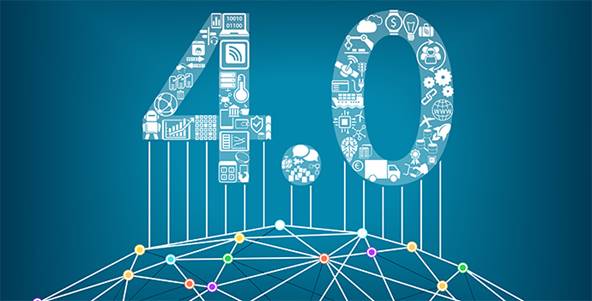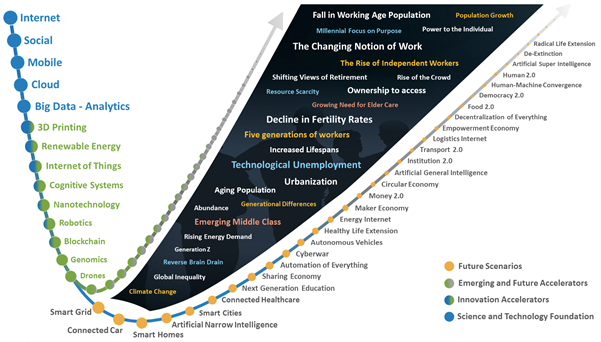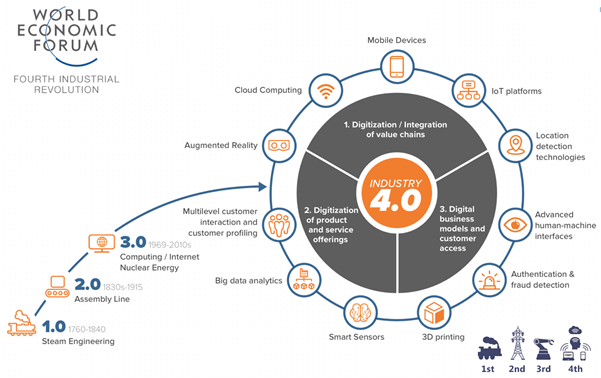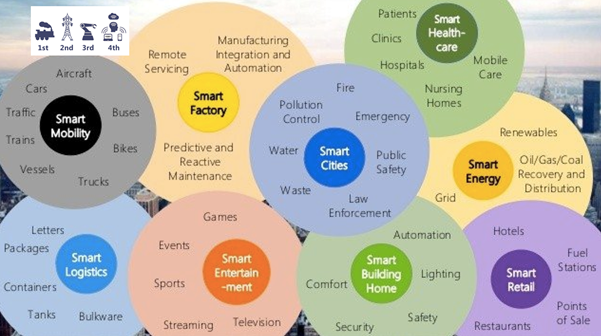What is driving the Fourth Industrial Revolution (4IR)?

The fourth industrial revolution, I4R is a reality and encompasses multi-fold impact to our lives actually due to digital revolution, but the phrase 'fourth industrial revolution' was first used in 2016, by World Economic Forum, which describes how this fourth revolution is fundamentally different from the previous three, which were characterized mainly by advances in technology. However, this fourth revolution, impacts our lives much more than before transforming each and every aspect of the digital world. The endeavour where advanced digital technologies such as big data, artificial intelligence, robotics, machine learning and the internet of things interact with the physical world and create an ever lasting impact to our health, our interaction with one another and how we work or do business, In fact the very definition of work itself is getting redefined as our contribution to social, economic and environmental aspects or the outcomes we desire.
Let's talk more about this, the 4IR is even described as an advent of "cyber-physical systems" involving entirely new capabilities for people, algorithm engines that empower self-learning and autonomous machines. It also represents entirely new ways in which technology becomes embedded within social and physical dimensions both internal ( read, body wearables) and external ( Read, IOT sensors) to the intellect metaphor. There are emerging proof points about genome editing, new forms of machine intelligence, breakthrough materials and approaches to governance that rely on cryptographic methods such as the blockchain, sincerely disruptive to the cause, context and the capabilities thereof.

It is even debated that Fourth Industrial Revolution may affect inequality across economies as well as within them due to increasing flexibility of capital in the form of robots and other advanced manufacturing systems that may erode the comparative advantage currently enjoyed by many emerging and developing countries, which are focused on labour-intensive goods and services, might even lead us to think differently on our belief of work and work packages will emerge more strategic leverage than tactical menial jobs. The combination of the digital world with emerging technologies is creating new "digital divide", expanding access to lethal technologies to select few and making it harder to others rising inequality and could lead to further fragmentation than unification. However, on the other hand few believe that the digital media is increasingly becoming the primary driver of our individual and collective framing of society and community, connecting people to individuals and groups in new ways, fostering friendships and creating new interest groups, even transforming the traditional markets. Thus challenging policymakers to keep up with the pace of change and dynamicity of these changes, integrations and connections between entities and in this fast changing pace, the process of setting rules and standards and validations must remain secure and in tune with technological improvements, that really is the challenge!
World Economic Forum (WEF) executive chairperson Professor Klaus Schwab aptly pointed out that to fully realise the benefits of the Fourth Industrial Revolution, understanding its concepts and potential is insufficient, it must be "embraced" on a societal level to maximum possible benefit through multi-stakeholder collaboration.Industrial Revolution,
Furthermore, such dynamic connections or collaborations transcend many traditional boundaries of interaction. Emerging technologies, particularly in the biological realm, are also raising new questions about what it means to be human. The 4IR is the first where the tools of technology can become literally embedded within us and even purposefully change who we are at the level of our genetic makeup. It is completely conceivable that forms of radical human improvement will be available within a generation, innovations that risk creating entirely new forms of inequality and class conflict. These thoughts are scary yet open up new dimensions which we humans never would have faced or even strategized enough, the rise of machines, is it?
The First Industrial Revolution a century ago used water and steam power to mechanize production, just start of this century the Second used electric power to create mass production and after 75-80 years the Third used electronics and information technology to automate production, that's what we call digital revolution. Now just a decade into digital world we have abilities and innovations that are truly disruptive causing the 4IR, Fourth Industrial Revolution. The scale and size of this 4IR is aiming to solve multiple and multi industry/domain problems be it manufacturing, supply chain, healthcare, finance, governments, education and many more social, economic and techno-commercial verticals.
What's Driving 4IR?
Undoubtedly, first four key players are Cloud, BigData, IoT and AI/ML followed by others...
The fair divide between Data, Devices and Datacenters these key technologies are playing major role in the 4IR metaphor..
- In today's dynamic world data remains key assets and terminology encompasses anything between elements of a transaction, trends to predictions and forecasts for a data driven world.
- The second key component is devices, this again ranges from the cell phones, wifi controllers, laptops / computers, field sensors to autonomous cars and industrial robots all deployed in the perimeter sensing, usable space or at the core of the transformation.
- The scale in which the digital transformation demands compute, storage and processing of this massive scale of data in real-time, the datacenter is housing the cloud, distributed applications, databases, infrastructure elements ( read routers, switches, servers, storage gamut of erstwhile IT assets) and algorithms that drive the 4ir is unprecedented. The edge, gateways and clouds are changing the way we looked at information technology just a decade away.

On the other hand there are so many streams of technologies and frameworks evolving to solve newer use cases of disruptive innovations, these have become industries on their own, The Artificial intelligence and Analytics, Internet of things, BigData and Microservices along with cloud computing has painted the canvas. let's us have a quick glance in select few transformative strategies / uses cases.. typically the forum Industry 4.0 illustrates these drivers aptly, the top five technological advancements in these areas are the key levers of disruption, each area has demonstrated proof of value and has an immense potential going forward.
1. Augmented Reality (AR) is used to enhance natural environments or situations and offer perceptually enriched experiences, it is an interactive experience of a real-world environment whose elements are "augmented" by computer-generated perceptual information, sometimes across multiple sensory, modalities, including visual, auditory, haptic, somatosensory and olfactory. Augmented Realities can be displayed on a wide variety of displays, from screens and monitors, to handheld devices or glasses. Google Glass and other head-up displays (HUD) put augmented reality directly onto your face, usually in the form of glasses. Handheld devices employ small displays that fit in users hands, including smartphones and tablets. As reality technologies continue to advance, augmented reality devices will gradually require less hardware and start being applied to things like contact lenses and virtual retinal displays. It is emerging as one of the key drivers of the tech economy. By some estimates, the total value of the AR market is expected to reach $100 billion by 2020.
2. Cloud Computing, according to Rightscale survey in 2017, The percentage of enterprises that have a strategy to use multiple clouds grew to 85 percent (vs. 82 percent in 2016) with 58 percent planning on hybrid (vs. 55 percent in 2016). There was also an increase in the number of enterprises planning for multiple public clouds (up from 16 percent to 20 percent) and a concurrent decrease in those planning for multiple private clouds (down from 11 percent to 7 percent). It is safe to conclude that we have passed the hill and cloud computing is rendering now as an old school terminology, the latest measure of the modern application platforms and databases is to be "Cloud native" "Cloud Native" is an approach of designing, building and running applications, services and eco system of continuous integration, container engines and orchestrators, modern databases etc on top of infrastructure-as-a-service offerings of cloud service providers with an objective is to deliver the services with speed ( read reduced time to market), scalability (Read, Infinite resources on demand / run time) and finally achieve cost benefit.
- Speed: companies of all sizes now see strategic advantage in being agile in the their GTM strategies fully powered by cloud,. By this we mean moving from weeks of test and development cycles to days or even hours. This is creating a major cultural shift within the developer community, transitioning from big bang projects to more incremental improvements in smaller work packages, agile way. It also talks about managing risk as well, at it's best a Cloud Native approach is about de-risking without losing grip on accelerating the change, thus allowing organization to deliver product and services more aggressively and thus become more responsive to customer needs.
- Scale:as businesses and the solution spectrum grows, it becomes strategically necessary to support more users, locations, workloads and many emerging technologies with a broader range of devices, while maintaining responsiveness, managing costs, and not falling over, i.e. truly distributed and available round the clock on demand.
- Cost Benefit: in the new world of pay per use, consuming infrastructure-as-a-service will be a strategic approach to pay for consumed resources only as they're used and scaled or shirked on demand - as new customers come online, more functionalities are required on the fly for select processes. It the paradigm shift from up-front CAPEX (buying new hardware in anticipation of forecasts) to OPEX (paying for consumed resources / servers per month on-demand).
The worldwide public cloud services market is projected to grow 21.4 percent in 2018 to total $186.4 billion, up from $153.5 billion in 2017, according to Gartner, Inc. The fastest-growing segment of the market is cloud system infrastructure services (infrastructure as a service or IaaS), which is forecast to grow 35.9 percent in 2018 to reach $40.8 billion as per Gartner.
3. Mobile computing have changed the way we interact with users, applications and other wearable devices, with various kinds of mobile devices available, it's no wonder that many people are less location-dependent for both work and play than ever before. The mobile computing industry has been a dynamic place for quite some time with a lot of new trends and innovations due to which mobile computing has come a long way, from the first laptop to today's proliferation of smartphones and tablets. Internet searches are almost wholly dominated by Google algorithms and for the last few years Google has been rewarding websites which are mobile-device friendly and have responsive designs. Therefore, developers are investing a lot of resources into catering to Google algorithms and gaining traffic to their websites. While it may be difficult to predict the path that smartphone development is going to take, the app market trends suggest that mobile app development for enterprise is going to be the next big thing. It also appears that mobile-oriented SEO and Google algorithm-oriented computing are going to define the business strategies of smartphone makers. To say that social media is a global phenomenon is almost an understatement, as the number of worldwide social network users is expected to grow from 2.34 billion in 2016 to around 2.95 billion in 2020, around a third entire population of earth. This surge of social media is due to the growth of mobile users in the past decade and the increasing affordability and reach of mobile internet. Today users are on mobile handsets more than any other connected device using social networks for chat, video, voice and other key services such as mobile wallets, shopping and gaming, streaming content services such as Netflix etc.
4. IoT Platforms are evolving at much faster pace as they are the reason extending the periphery of the internet from users, applications to the edge devices and sensors. This was never experienced or envisaged to resultant eco systems in healthcare, agriculture, logistics and automotive industries by large. The use cases such as smart cities, connected cars, predictive maintenance, process control, telemetry, smart power-grids, smart metering, asset / fleet tracking, robotics are all powered by underlying IoT ecosystem that connects sensors, edge devices / gateways further up to the cloud. With wearable devices the IoT has started impacting our personal health, using drones it improved surveillance, with multiple sensors made our homes smarter and safer finally with embedded devices it is encompassing our consumer electronic devices remain connected and controllable remotely. The use cases are plenty and new ones are emerging faster than ever before thus we can expect this domain to keep surprising us positively impact our lives for sure.
5. Bigdata Analytics & AI has been the most eye caching of all, with multi-fold increase in the workloads and userbase the data trails created from their transactions, metadata and unstructured content types as an outcome of social media the data is now becoming a true digital asset and with its variety, velocity, volume and variability the value it delivers is exponential. The datafication and artificial intelligence have taken the 4IR game to the next level of extended human capabilities and intellect. There is a big zeal and innovation to leverage the machine learning, computing platforms (Read, CPU, GPU, FPGA) and big data together power the future of mankind coupling them with machines. The thought process and strategies are well baked and shows unified reality of the course we can imagine our future. The self-learning ability of machines ( Read, AI Engine) in video, text and speech recognition and subsequent decision making that's when we call them artificially intelligent and autonomous decision making to drive outcomes is proven and seen large scale adoption in various industries. The structured and unstructured data resting in the archives of corporations resting without use beyond compliance is now getting monetized and generating value via insights and patterns driven by powerful algorithms and AI engines helping take business decisions based on past business knowledge. It is a real challenge to enable the convergence of bigdata and AI and inter-dependence of these technologies is where real successful outcome exists.

Unlike the earlier revolutions, the Fourth Industrial Revolution demonstrates the potential to solve global problems, increase yields, efficiencies and performance of products and services that impact large scale human population and transform lives. A key trend is the development of technology-enabled platforms that combine both demand and supply to disrupt existing industry structures, such as those we see within the "sharing" or "on demand" economy. These technology platforms, rendered easy to use by the smartphone, convene people, assets, and data-thus creating entirely new ways of consuming goods and services in the process. In the future, 4IR will also lead to a miracle, providing long-term gains in productivity and profitability. Transportation and communication costs will decrease, logistics and global supply chains will become more connected and cohesive, and the cost of trade will diminish, all of which will open new markets, employment opportunities, right skilling and thus drive positive outcomes on social, economic and personal front.